What Was And Is The Best 35mm Rangefinder Camera Ever Made
![]()
Moving-picture show has experienced a bit of a resurgence in the past decade and nosotros've seen a proliferation of never-earlier-fabricated film stocks and even brought some back from the dead. Only if you want to become started in film photography now, you'll need a camera. So where should yous offset?
Every bit a life-long, avid shooter of film — from 35mm to 4×five and feel with thousands of camera models — I take created this guide to point out some of the best 35mm camera models at various prices.
Each option is based on user feel and, naturally, my personal preferences. There are obviously hundreds, if not thousands, of options that others may adopt. And so, before you ask "what well-nigh such and such?" please proceed in mind that I probably already considered information technology, I probably love the photographic camera, and my decision to choose something else isn't a slight against it, but for the sake of this guide, some choices had to be made.
We'll be looking at 3 categories: 35mm SLR Cameras, 35mm Compact Cameras, and 35mm Rangefinder Cameras. Inside each of those, they are broken down into four pricing brackets: Ultra-Bargain, Bargain, Mid-Range, and Premium.
While used cameras tin come from a variety of sources, quality tin can vary. In our stance, the best U.S.-based sources for vintage cameras are Robert's Camera (UsedPhotoPro) in Indianapolis, Indiana, and KEH Camera in Smyrna, Georgia. Both offering six-calendar month warranties and free shipping on a majority of products.
At a Glance
The Best 35mm Film SLRs
Ultra-Bargain SLR: Yashica FX-103 Program
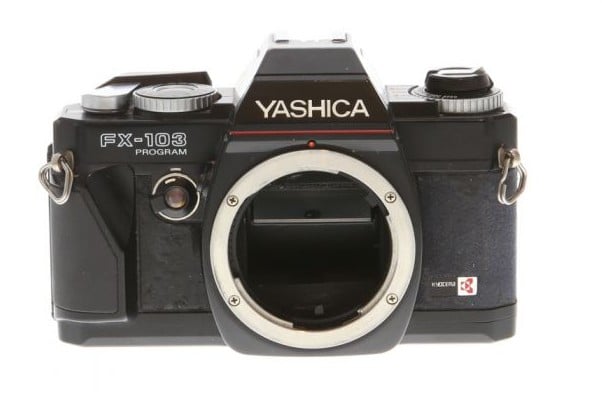
This is one of my favorite hidden gems of the flick world and tin can routinely be found with a Yashica 50mm lens for $100 or less. Information technology uses the Contax Yashica (C/Y) bayonet mount, which ways it tin use all of the extremely excellent Contax Zeiss lenses, many of which still hold their ain even on high-resolution digital cameras. In fact, some of the lenses were so practiced that their designs exist to this day in the Zeiss Classic and subsequently the Zeiss Milvus series.
The FX-103 Program has four modes: P (Program), HP (High-Speed Programme), A (Aperture Priority), and M (Manual). That's far more than most cameras in this toll range, plus it has an unusually extensive ASA range from 12 to 3200. There really isn't anything to complain nigh here.
Similar alternatives include the Yashica FX-iii and Yashica FX-three Super 2000.
The Best Bargain SLR: Minolta Ten-570 or X-700
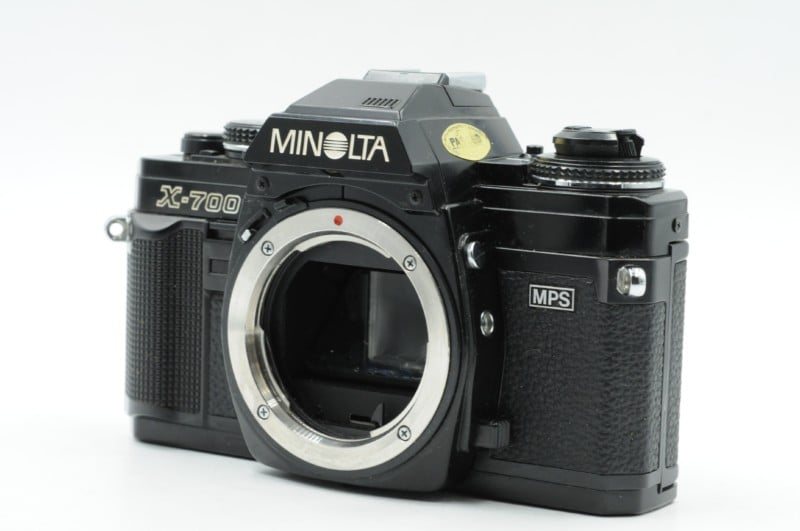
At that place are a number of bully options I considered here: Nikon FE, Nikon FM, Pentax K2, or MX, but ultimately settled on Minolta because the X-570 was one of my first cameras and they're powerhouses — loaded with features, and compared to the Nikons or Pentaxes, the glass is a corking deal more affordable. The X-700 has Program, Aperture Priority, and Manual modes; the X-570 lacks Program, which is honestly not a way I e'er utilise with 35mm cameras anyway. Otherwise, the bodies and features are well-nigh identical.
There are a plethora of not bad Minolta lenses bachelor at very reasonable prices; there is as well the renowned 58mm f/1.2 Rokkor which is a nice clamper of glass that produces nice, dreamy images wide-open up. Fifty-fifty that lens can be establish at a modest cost. Your regular 50mm f/i.8 or 50mm f/one.7 Minolta lenses are clay cheap, and 50mm f/1.4 or 55mm f/i.4 lenses are incredibly affordable as well.
Make sure to check compatibility betwixt lens types (Medico versus MC) if yous intend to use the X-700'southward program auto style (MC lenses are aperture priority or manual just).
Robert'due south Camera is rarely without several 10-700 bodies in stock.
The All-time Mid-Range SLR: Nikon F3 / F3HP
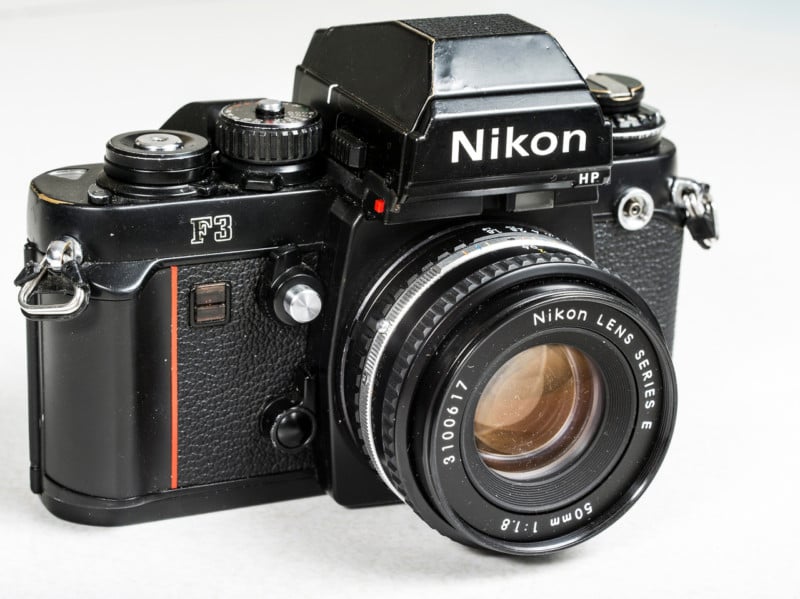
The Nikon F3 is i of the finest cameras e'er made. It is nothing brusk of perfect; it has a rock-solid build, amazing ergonomics, and is one of the virtually dependable cameras I've e'er come beyond.
The F3 is, unsurprisingly, the successor to the legendary Nikon F2, but now with a built-in lite meter (no clunky finder necessary) and discontinuity-priority automation. Similar Nikon's FE/FE2/FA models, the F3 has an electronically controlled shutter, and then information technology will not role without batteries. On a personal note, in my experience with thousands of cameras, at that place is no correlation regarding longevity or reliability and whether the camera is mechanical or electronic.
The F3HP is but the F3 with a high-eyepoint finder (very nice for those of u.s.a. who wear spectacles). Since the finders are interchangeable, a regular F3 can become an F3HP by swapping in the DE-three finder, and an F3HP tin can use one of the many other finders available – including the basic DE-2 finder. At that place'southward even a (very absurd) waist level finder available (DW-iii). Focusing screens are also hands interchangeable.
The Best Premium SLR: Canon EOS-1V or Nikon F6
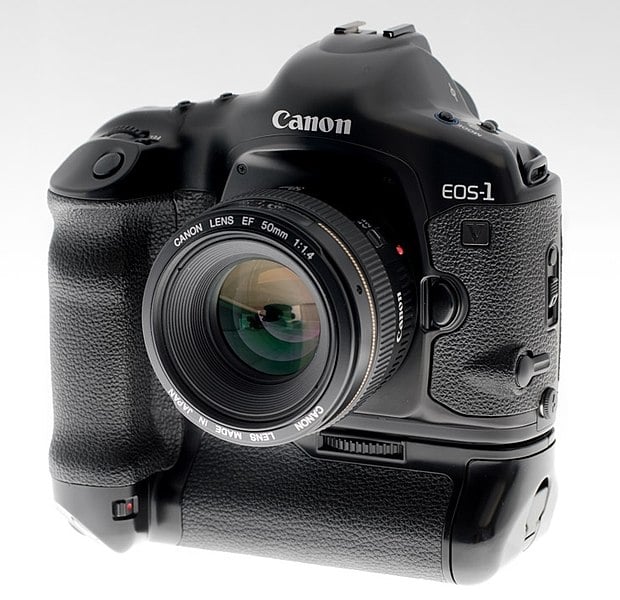
I was tempted to put the Nikon F2 Titan here, only I set aside my personal bias that sees the Titan equally my "white whale" of cameras to instead cull not one, but two of the all-time (and final) 35mm cameras always fabricated. Why two? Because they are both excellent, "tin't-go-wrong" options and the only thing that separates them is the lenses — if you already have EF mount lenses, you should get with the Catechism and if you accept F-mount drinking glass, you lot should cull the Nikon.
The Catechism EOS-1V, released in 2000, was the fifth generation of Catechism's top-of-the-line professional series which started with the F-1. Capable of an astonishing 10 frames per 2nd, it was the fastest moving-mirror film photographic camera always made at the time — simply stock-still pellicle mirror cameras like the Nikon F3H, capable of thirteen frames per second when used with the MN-ii battery, were faster.
With five metering modes — evaluative, spot, center spot, fractional, multi-spot, and focusing bespeak-linked spot — and 45 zone TTL (through the lens) phase detection autofocus, the EOS-1V was a powerhouse piece of technology. It can utilize any Canon EF lens made since the introduction of the mount in 1987, though you lot may come across issues with various 3rd-party lenses. Virtually, nevertheless, piece of work just fine. So capable and tech-filled was the EOS-1V, Canon would continue to manufacture it for another 18 years until they ended product of all non-digital bodies in 2018.
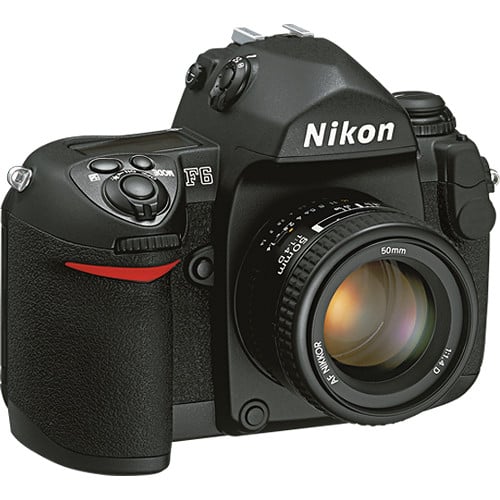
The Nikon F6 — unsurprisingly the 6th model in Nikon's highest tier of professional person models that began with the Nikon F in 1959 — was released in 2004, supplanting the besides excellent Nikon F5. While the F5 sported an integrated vertical grip, Nikon opted for a smaller, traditional trunk (with optional vertical grip) in the F6 — a design choice I personally prefer over the F5 for its versatility, smaller footprint, and 225-gram weight difference.
The F6 is fully compatible, including metering, with almost all F-mountain lenses since 1977. Non-AI lenses — unless they have been modified — and the newer E series lenses with an electronically controlled aperture are not compatible, and as with the Canon, you may encounter issues with some tertiary-party lenses. Like all Nikon autofocus SLRs (and DSLRs), the F6's crowning achievements were its remarkable focus tracking abilities via the Multi-CAM 2000 autofocus sensor module and its 3D Colour Matrix metering mode. Like the Catechism, the F6 would remain in production for over a decade until its discontinuation in 2020, at which time it was the last remaining film SLR nevertheless being manufactured.
The All-time 35mm Motion-picture show Compact Cameras
The Best Ultra-Bargain Compact Film Camera: Minox 35 GL or GT
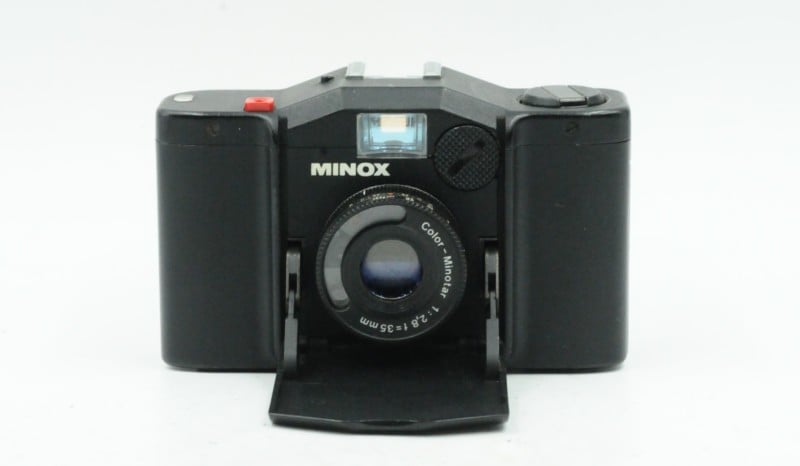
These piddling fellas are such gems. They're maybe the smallest 35mm camera ever made (I believe that was the company's claim at the fourth dimension), though others come close. It is past no means perfect — the exposure command is limited, the film advance can be finicky (likely due to how tiny and cramped everything is), it's zone focus merely, and the foliage shutter is prone to failure at a higher rate than others.
No camera ever made is more deserving of the adjective "discreet" than these cameras. Zone focus only and the limitation of aperture-priority just metering system means you really but need to heighten the camera to your eye for framing. The leaf shutter and manual flick advance mean you'll never hear the photographic camera in action unless y'all happen to be alone in a padded isolation room.
There were xviii models released over 24 years, from 1974 to 1998, starting with the Minox 35 EL. Aside from the fixed focus Minox 35 AL, all models were fitted with one of two Tessar-blazon lenses — the 35/2.8 Color Minotar and the later 35/2.8 MC Minoxar. While the Minox 35 GT-X or GT-Due south may be the all-time of them all, the before GL and GT — both of which can exist identified by their orangish shutter release button — are the best value options. I besides take a personal preference for the Color Minotar over the MC Minoxar.
The only difference betwixt the two is the addition of an electronic self-timer in the GT, as well every bit the relocation of the cable release socket to a position less likely to upshot in accidental triggering.
Best Bargain Compact Film Photographic camera: Olympus XA series
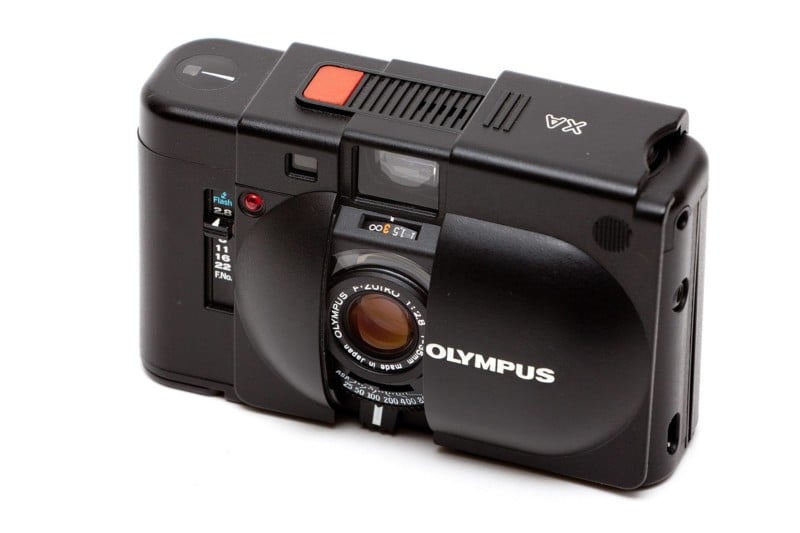
The Minox 35 is just almost the merely discreet, pocketable 35mm camera out at that place that comes in at an affordable price. Designed past Yoshihisa Maitani, chief photographic camera designer of Olympus Optical Co Ltd. and the human behind the Pen, OM, and mju serial of cameras, the Olympus XA line comprised five distinct models.
The first model, the Olympus XA, is a tiny rangefinder-coupled, aperture-priority (with +1.five backlight compensation) compact fitted with a sterling half-dozen-chemical element 35/two.8 F.Zuiko lens and a foliage shutter upwards to one/500 of a second. The following model, the XA1, is a fixed-focus bespeak and shoot with a 35mm f/4 lens, programmed auto exposure, limited film speed settings of ASA 100 and 400, and maximum ane/250th of a 2nd shutter. The XA2 uses a four-element Tessar variant 35/iii.v D.Zuiko lens, leafage shutter up to 1/750th of a second, programmed motorcar exposure, ASA from 25 to 800, and a 3-position zone focus mechanism.
The XA3 retained identical features every bit the XA2 but added automatic DX coding, ASA 1600 support, and the backlight bounty characteristic from the original XA. Finally, the XA4 pivoted to a new 5-element 28mm f/iii.5 Zuiko "macro" lens, programmed auto exposure, maximum 1/750th shutter speed, and a new scale focus mechanism. Different the XA2 and XA3, which but gave users the choice of one of three focus positions (1.2-1.8m, 1.8m-half dozen.3m, and 6.3m to infinity), the XA4's sliding calibration allowed for incremental positioning anywhere betwixt infinity and the camera's 0.3m minimum focus altitude.
All of the Olympus XA models remain quite affordable and tin ordinarily exist found for under $200. Your option volition depend on the features you lot want. The faster 35/ii.8 lens and rangefinder coupling of the original XA, along with aperture priority, allows for a bit more versatility and control compared to the XA2 and XA3. It also commands the highest prices of the bunch. If you lot adopt a wider 28mm lens, the XA4 is the manner to go. The XA1, in my opinion, is a poor choice with no clear benefits — but many deficiencies — over the other models.
The Best Mid-Range Compact Film Camera: Rollei 35S
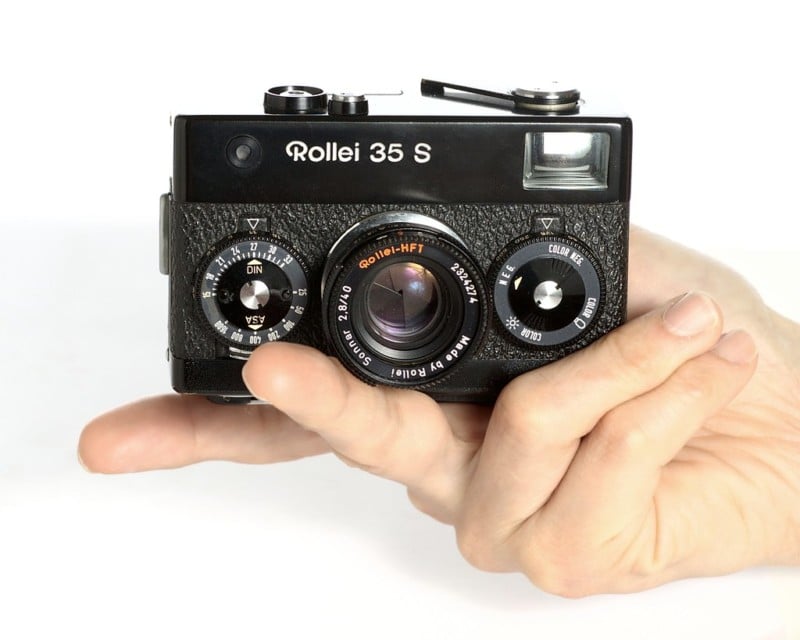
In 1966, DHW Fototechnik — successor of Franke & Heidecke of Rolleiflex and Rolleicord fame — introduced the Rollei 35 at Photokina. The camera — at the time the smallest 35mm ever made — was designed past Heinz Waaske, main pattern engineer of Wirgin, and featured a somewhat odd, boxy pattern with a battery-powered CdS light meter and a fantastic, collapsible Carl Zeiss Tessar 40mm f/3.v lens. Later on models transitioned to a 40/3.five Rollei-HFT Tessar lens and marked "Made by Rollei," but the optics are identical to the original Zeiss. Furthermore, from 1972 to 1973, some Rollei 35 cameras featured a xl/iii.5 S-Xenar lens made by Schneider.
Because of the Rollei 35's success, in 1967 a higher-cease variant was planned for market, but due to the production's shift from Germany to Singapore, information technology would exist a number of years before it saw an audience. Somewhen, the Rollei 35S — now the most desirable of Rollei 35 models — debuted with a new, faster 40mm f/2.8 Zeiss-designed and licensed Sonnar lens. Like the Tessar, focus was controlled via a ring at the stop of the lens, while the aperture and shutter speed were ready via dials positioned to the right and left of the lens, respectively.
As with all Rollei 35 models, the Rollei 35S featured a big, bright viewfinder without focusing aids, which meant the camera was, similar the Minox 35, zone focus just with a match needle metering system. While the design of the camera — from its left-handed shutter advance to its quirky controls — can be off-putting to some, at that place's a lot of logic (and amuse) that begins to click once y'all use the camera. Shutter speed, aperture, and light meter values can be hands seen and adapted while looking down at the photographic camera and the quality of the Zeiss-designed 40mm Sonnar lens speaks for itself.
The Best Premium Compact Film Camera: Konica Hexar AF or Nikon 28/35Ti
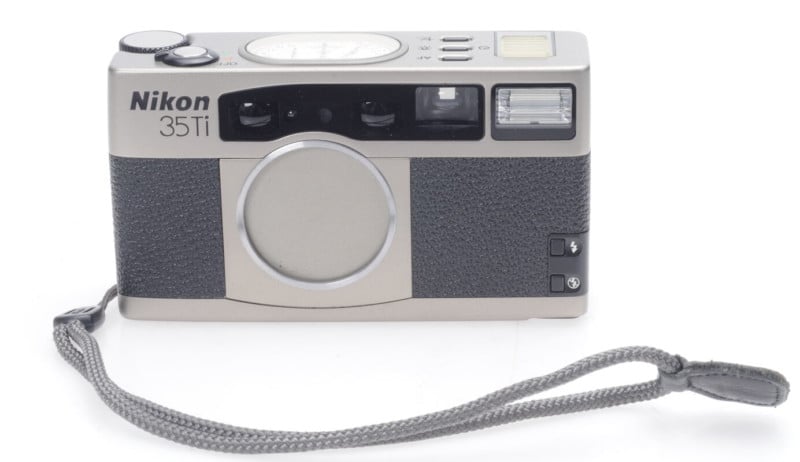
I'm including 2 options here considering they are both infrequent and almost the aforementioned price, yet ane or the other may better suit your personal preferences.
At that place are a lot of options when information technology comes to premium compacts and plenty of other articles written about them. I absolutely honey the Nikon Ti series (in either 28mm or 35mm flavors): they're fitted with utterly fantastic lenses and the — at first odd and potentially off-putting — dials on top are one of my favorite points of design in any camera. They're the only autofocus point-and-shoot camera I tin can think of that allows you lot to run across your aperture, exposure compensation, focus distance, and the number of exposures remaining without raising it to your eye. Shutter speed, all the same, is only displayed in the viewfinder.
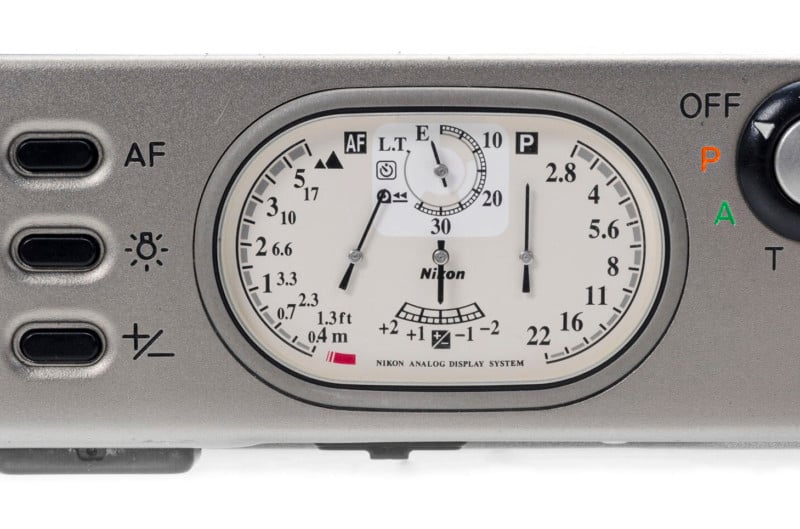
My personal choice favorite, nevertheless, is the Hexar AF considering it's the only autofocus, auto-advance point and shoot that is quiet enough (unbelievably so, in this instance) for me to describe it as inconspicuous. The Nikons, the Minolta TC-ane, the Contax T2/T3 — all are fantastic cameras with top-notch optics, but they're stripped of discretion by their loud, whirring film advance motors.
The Hexar AF is a bit larger than others due to its significantly larger (and magnificent) lens, but none of these cameras will comfortably fit in a jeans pocket or shirt pocket anyhow. Later you cross that betoken, the differences become bookish in my stance — all of them volition practise only fine in a jacket pocket or dangling from a wrist or neck strap. Nevertheless still, the Hexar is undeniably larger, nevertheless, the weight is similar to the others because of their titanium-bodied construction.
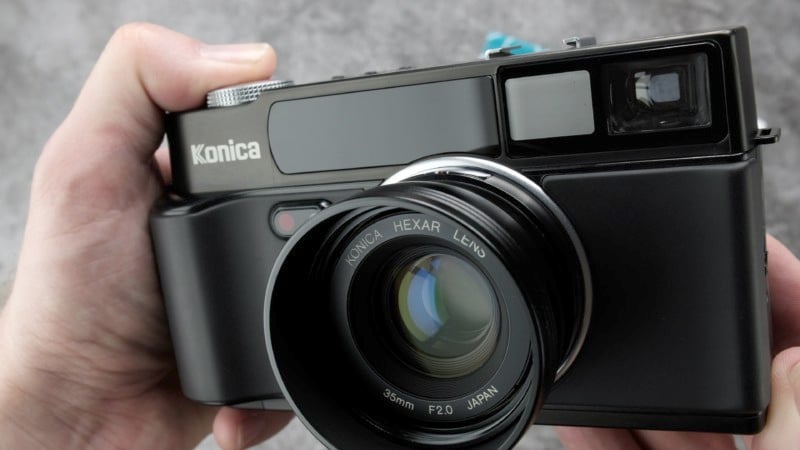
The Hexar also excels in several other ways due to its larger construction: there is actually a slight grip rather than the flat-fronted, indigestible designs of the others, and the viewfinder is of significantly higher magnification — closer to an bodily rangefinder than a signal and shoot. Many compacts take (let'south face up it) bottomless viewfinders, with the Leica Minilux being a particularly notable offender. This is an inherent trade-off in return for their atomic size.
Of grade, if size is a priority, the Nikons, with their smaller bodies and fully retractable lenses, are going to win out. You absolutely won't lose annihilation to the Hexar in terms of sheer image quality — though the Hexar'due south lens is a total stop faster — and there'south one notable reward in favor of the Nikons: matrix metering.
Get-go introduced in the Nikon FA and later the F4, Nikon created what is today the about ordinarily used exposure mode. Other cameras of the time had a spot or center-weighted meter, which tin be tricky to use under some circumstances. Matrix metering (also known as evaluative, multi, et cetera) uses a microprocessor to analyze a scene, compare it to similar scenes in its library of estimator knowledge, and choose an exposure based on what it believes is best for that scenario. Taken for granted today, it was incredibly remarkable applied science when commencement introduced and merely improved over time.
The Best 35mm Film Rangefinder Cameras
The Best Ultra-Bargain Rangefinder Photographic camera: Canon P / Canon 7
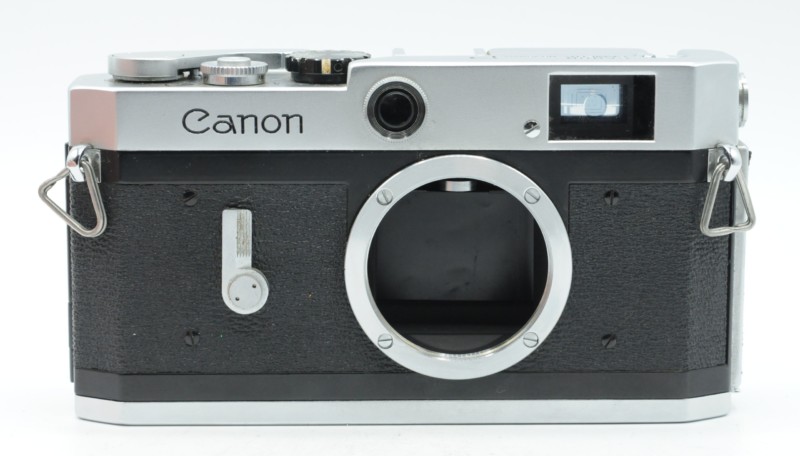
When nosotros think of rangefinders, our first thoughts drift to those of Leica and Zeiss Ikon, the two earliest and virtually highly regarded rangefinder camera manufacturers. But the market landscape, particularly in the 1950s, looked quite a fleck different — numerous Japanese manufacturers offered options more attainable to those without deep pockets. Nippon Kogaku (afterwards Nikon), Chiyoda Kogaku Seiko (later Minolta), Tanaka Kogaku, Showa Kogaku — there was no shortage of options, many of which used Leica's M39 thread mount.
The first rangefinder to hit the market from the Catechism Camera Company was the Hansa Canon in 1936, which was fitted with a Nikkor bayonet focusing mount. At the time, Canon did not have the means to manufacturer its own lenses, and so it turned to Nippon Kogaku (Nikon) for help. This cooperation continued for about a decade until Canon began manufacturing its own Serenar branded lenses. In 1952, the company released the Canon IIIA with its standard Leica M39 pitch thread; subsequent Canon lenses were now uniform on Leica thread mount bodies.
Leica's release of the revolutionary M3 in 1954 presented a challenge for other manufacturers — its huge, bright viewfinder, simpler film loading, and move from a moving picture advance knob to a lever winder all made for a significantly improved user experience. Canon responded with the Canon VT in 1956, but information technology wasn't until the release of the Catechism P (often referred to equally the "Populaire") in 1958 that the company saw truly huge success.
The Catechism P bundled already existing features from other companies — the integrated rangefinder/viewfinder and non-rotating shutter speed punch from Contax, the lever accelerate from Leica, the huge 1:1 viewfinder from Nikon to name a few — and presented them in an affordable and very undecayed body. At that place were also some improvements: a hinged door, which would eventually become the standard camera design, 35mm framelines and parallax correction in the viewfinder, and metal shutter curtains, preventing burning.
The result was the well-nigh popular camera the company had ever fabricated with well-nigh twice every bit many sales as whatever previous model.
Three years later, Canon would release the Canon seven, whose biggest design alter was the addition of a selenium exposure meter into the camera'due south elevation. The Catechism 7 was likewise coupled (both literally and figuratively) with the fastest lens e'er made at the fourth dimension: the Catechism "Dreamer" 50mm f/0.95.
Both the Catechism P and Canon 7 are very desirable rangefinder options, with a plethora of affordable M39 lenses to choose from. The Canon P, despite being the less avant-garde of the two, commands college prices, but tin can often be institute for nether $225, though prices accept been on the rise. A working Canon 7 can exist sourced for under $150, though if you intend to use the light meter, exist certain to check its accuracy equally selenium meters often didn't stand the examination of time.
The Best Deal Rangefinder Camera: Contax G1
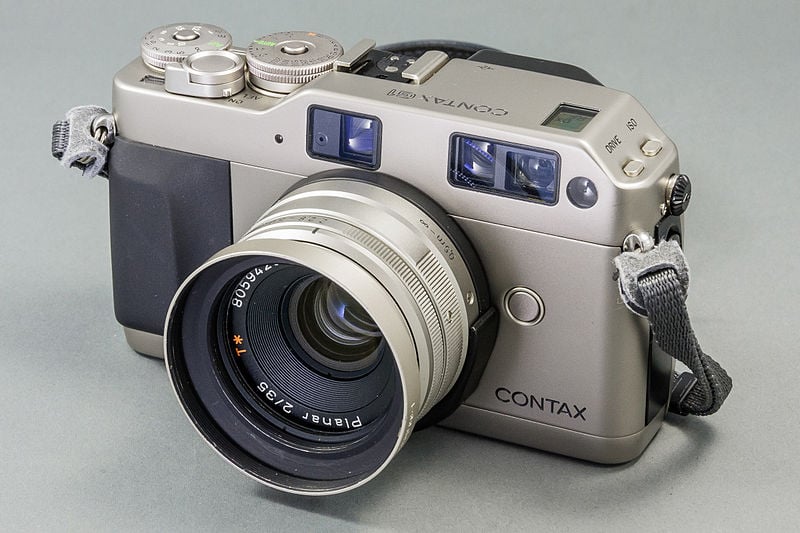
Contax, again pioneering some of the almost innovative technology, surprised the camera earth in 1994 when information technology released an autofocus rangefinder. That camera was the G1 — a titanium-clad body with electronically controlled exposure, autofocus, and rangefinder system. Lenses are spiral-driven via an in-body motor that turns a pin on the lens mountain, driving the helicoid back and forth.
Unlike every other rangefinder photographic camera to that point (and since so), the viewfinder field-of-view changes depending on the lens beingness used. Instead of relying on a small-scale box in the center of the finder for a 90mm lens, for example, the viewfinder "zooms" to fill up the unabridged frame. No affair your chosen focal length, the unabridged viewfinder will be used.
None of this itself is a reason to add it to your purse, but the lenses are what clinch the bargain. Like most Contax lenses, G-mountain glass was made by Carl Zeiss, and they are some of the company's finest piece of work. Ranging from a 16mm Hologon to a 90mm Sonnar, all of the lenses are optical works of art. In my stance, the two.eight/ninety Sonnar and 2/45 Planar stand up out as the crown jewels.
The ninety Sonnar can exist found for very reasonable prices and is a must-take lens for any G1 or G2 owner. It also adapts easily to most mirrorless systems as well — though due to the lack of a focus ring on M lenses, focus must be controlled by a band on the adapter, which is not as bad as it sounds in practise. I recommend either the Metabones or the Fotodiox Pro, with an edge to the Metabones. There are even autofocus adapters available — the Techart TZG-01 for Nikon Z mount and the Shoten GTE adapter for Sony Eastward mount. The 28mm and wider lenses don't perform besides on most digital bodies, merely the 45 and 90 lenses sing.
If you lot search for Contax G1 bodies, you may find some described as "green label." These are updated versions with modified ROM and volition have a literal dark-green label inside where the picture canister sits. The upgrade allows these bodies to use the 21mm and 35mm lenses (regular G1's can but use the 16mm, 28mm, 45mm, and 90mm lenses). Only the G2 tin use the 35-70mm zoom, which happens to be the just rangefinder zoom lens ever fabricated.
The Best Mid-Range Rangefinder Photographic camera: Minolta CLE
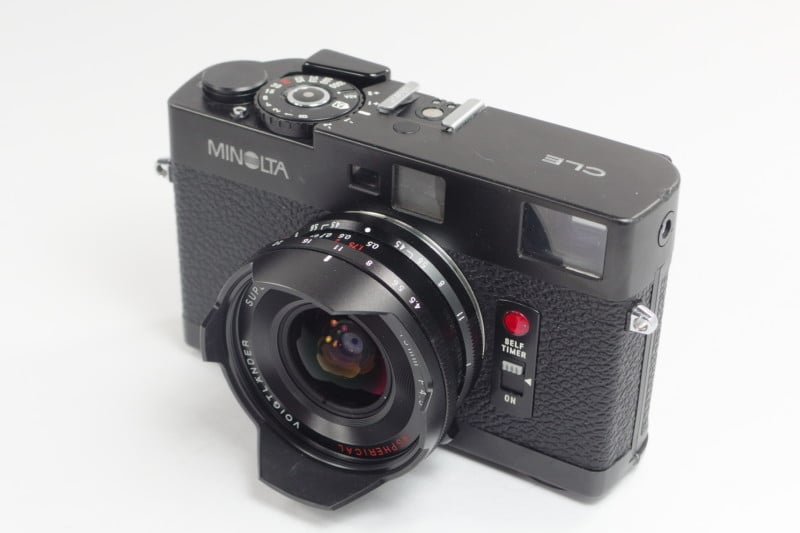
When it comes to rangefinders, the Minolta CLE is i of the best deals on the market.
Its predecessor, the Leica CL (sometimes labeled "Leitz Minolta CL"), was designed in concert with Minolta and released in 1973. Different many other M-mount rangefinders, the CL has framelines for 40mm lenses in addition to 50 and 90mm. Leica and Minolta designed and released the Leica 40/2 Summicron with the photographic camera likewise every bit the Leica Elmar-C ninety/4.
Like the M5 that was released one year prior, the CL uses a CdS meter on a pivoting arm in front of the shutter that drops down just before the moment of exposure. Considering of this, certain lenses cannot be mounted without damaging the arm: those with excessively protruding rear elements (often super broad-bending) and some collapsible lenses (which can exist used if you don't fully plummet them).
Seven years subsequently, Minolta introduced the very similar Minolta CLE — one of the virtually avant-garde rangefinders of its time due to the inclusion of aperture-priority autoexposure (something Leica wouldn't accomplish until the release of the M7 decades later). Dissimilar the CL, the CLE utilized a silicon photodiode meter that measured the light reflected off the unique spotted patterning of the shutter pall — protruding rear elements or collapsible lenses were no longer an result.
The CLE besides added a frame line for 28mm lenses in improver to 40 and 90mm lenses — the former was paired with the release of Minolta's new G-Rokkor 28/2.8. Minolta besides released the M-Rokkor forty/ii and Thousand-Rokkor 90/4 — identical to the previous Leica versions optically, though the Leica variants are single coated, while the Minoltas are multi-coated.
The Minolta CLE is not only superior to the Leica CL past every metric, but usually, not much more than expensive, and the 1000-Rokkor lenses are incomparably cheaper than their (single-coated) Leica counterparts.
The Best Premium Rangefinder Camera: Leica M4-2 or M4-P
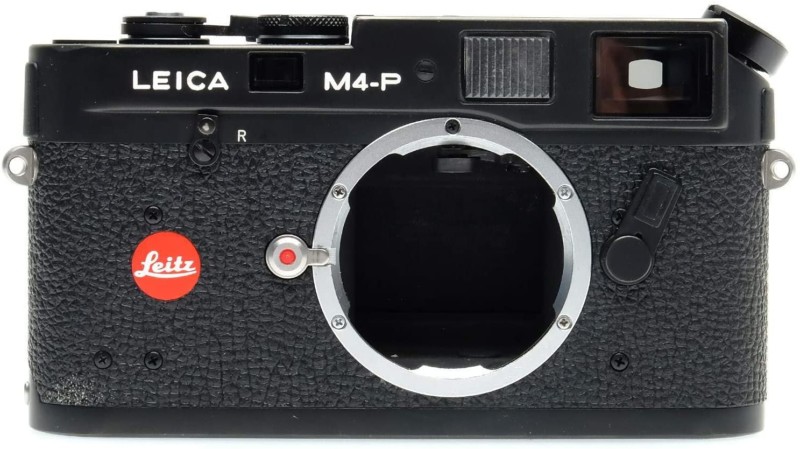
There are legitimate reasons to choose simply about any Leica rangefinder here — the M3, M2, M4, M5, M6, M7, M-A, and MP are all worthy for their own reasons. The M3 may be my personal favorite considering of my dear for 50mm lenses and that gorgeous, bright 0.91x viewfinder. Just if I had to selection the all-time all-arounder, information technology would be either the M4-2 or M4-P.
The production of the Leica M4 stopped in 1972 and its successor, the Leica M5, was released to a very lukewarm reception and poor sales. Ironically, the M5 has risen in value more any other model over the by few years — information technology has at least doubled in 4 or five years. In response to the M5's market failure, Leica restarted production of the M4, and in 1977 released the M4-ii using a streamlined production procedure. The M4-2 saw the cold shoe swapped for a hot shoe, the removal of the self-timer, and motor drive compatibility. Like the M4, it had framelines for 35/fifty/xc/135mm lenses with a 0.72 magnification viewfinder.
Iv years afterward the M4-P was launched, which added framelines for 28/75mm lenses and the trademark Leica red dot on the forepart of the camera.
While the afterward M6 and M7 cameras were fitted with a congenital-in light meter, they too come at a significantly higher cost and the M7 is entirely dependent on its electronics. For me, the M4-2 and M4-P striking the sweetness spot of versatility, build quality, aesthetics, and price. If you adopt chrome over black, you'll accept meliorate luck with the original M4, though — most M4-2 and M4-P bodies are black.
Epitome credits: Header photo by Mia Domenico.
Source: https://petapixel.com/best-35mm-film-cameras/
Posted by: perrythout1960.blogspot.com


0 Response to "What Was And Is The Best 35mm Rangefinder Camera Ever Made"
Post a Comment